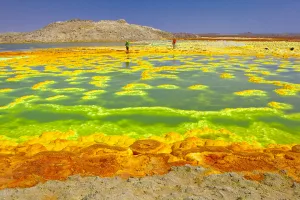The Danakil Desert, stretching across Ethiopia, Eritrea, and Djibouti, is one of the most extreme environments on the planet. Covering over 136,000 square kilometers, this desert is known for its blistering heat, with temperatures soaring above 50°C (122°F) and annual rainfall barely reaching 25 mm. Located within the Afar Triangle, the Danakil Desert is a land of volcanoes, salt flats, and the dramatic Danakil Depression.
Dallol, situated in this desert, holds the record for the highest average temperature of any inhabited place on Earth. Between 1960 and 1966, the annual average temperature in Dallol was a scorching 34.6°C (94.3°F). This intense heat is amplified by the desert’s low elevation, with parts lying more than 100 meters below sea level.

Geologically, the region was shaped by tectonic forces as the African and Asian plates drifted apart. Volcanic eruptions and rising seas left behind massive salt deposits, which the Afar people still mine today. These salt miners, often seen leading camel caravans across the barren landscape, extract salt blocks for sale in distant markets.
The Danakil Desert is also home to the Afar people and the famous anthropological discovery of “Lucy,” a 3.2-million-year-old Australopithecus afarensis fossil. Despite its harsh conditions, the desert is rich in geological wonders, including active volcanoes like Erta Ale, bubbling lava lakes, and sulfuric springs. It remains a land of both scientific curiosity and harsh survival, where few dare to venture.




